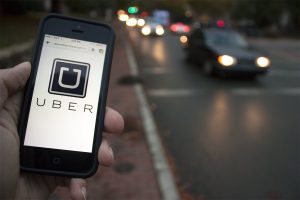Over the past two years, perhaps no other private tech company has generated the kind of press, positive or negative, that Uber has.
The popular ridesharing app, a mainstay on nearly every Georgetown student’s smartphone, has seen a stratospheric rise over the last two years, revolutionizing the transportation industry across the globe. As recently as this past month, Uber expanded its latest round of financing by an additional $1 billion, placing the company’s valuation in the neighborhood of $41 billion. By comparison, other private tech companies such as Airbnb and Snapchat are valued at $13 billion and $10 billion, respectively, while Uber’s closest rival Lyft is miles behind at $2 billion. Although the success of Uber has been a boon for investors, management, and users of the app, there has been one group that feels as though they have not reaped their share of Uber’s success: the drivers.
Over the past couple of years, Uber aggressively propelled its growth through the expansion of the UberX platform, a move that was facilitated in large part by the company’s ability to recruit taxi drivers in many key urban markets through the promise of wages as high as $30 an hour. However, as drivers have realized their wages are nowhere near what was advertised—the Wall Street Journal reported drivers have been earning around $19 an hour—they’ve sought to ameliorate the situation through the inclusion of tips within the Uber app itself. Earlier this month, Peter Faris, an Uber driver here in DC, launched a petition asking Uber to incorporate optional gratuity into the interface of the Uber app, a step that Lyft has already taken.
As a frequent user of Uber, I feel as though Uber should avoid such a move as it not only plays into the over-proliferation of gratuity into nearly every single service sector, but also takes away from what has made Uber so preferable to taxis. Drivers who want Uber to offer a gratuity feature within the application stress that it would be purely optional, as a means for passengers to reward exceptional service. However, passengers can already do that via cash tips, should they feel so inclined. The main issue is that, once optional gratuity is added, it quickly morphs into something compulsory.
Take, for example, taxis; while tipping cab drivers is meant to be optional, it seldom feels that way, as drivers have grown to expect tips. On multiple occasions both here in D.C. as well as other cities, I have been disparaged or accosted by cab drivers that felt as though I didn’t leave them a sufficient tip. Keep in mind, on these occasions the drivers did not offer to place my bag in the trunk, get me there any faster than usual, or engage me in conversation. For simply doing their job, i.e. getting me from point A to point B, they felt entitled to a tip of 20 percent or more. In D.C. cabs, when paying with a credit card, the default amount for tips listed are 20 percent, 25 percent, and 30 percent, a not-so-subtle attempt at pressuring passengers to leave higher gratuities.
As soon as tipping becomes the norm for any particular group, it no longer becomes an incentive for the service provider to excel at his or her job, and a floor quickly develops for what is generally accepted as the minimum tip. While waiters and waitresses present a slightly different case because their wages are structured around gratuity, in most cases restaurant patrons have established a floor of almost 15 percent, even for bad service, limiting incentives for going above and beyond. I can’t say for certain adding tips into the Uber app will reduce the quality of service, but once customers are faced with the “optional” tip screen, it will, in my opinion, develop into more of an expectation than a reward for a good experience.
Tipping could also become disruptive to the business model that has made Uber so successful. One of the aspects of the Uber app is the rating system by which users can rate drivers and vice versa. Under this system, users with higher ratings could be more inclined to have their ride request accepted by one of Uber’s drivers. Gratuity, however, could throw a wrench in this system. Will drivers tarnish the ratings of users who don’t leave a tip, or don’t tip enough? If that is the case, users will be forced to tip or else risk having their rating fall to a point at which they will not be able to catch rides.
At the end of the day, Uber, despite its numerous public relations scandals, has won over the public through its combination of convenience and competitive prices. While good service deserves a reward, a built-in tip function ultimately diminishes both of those two elements of Uber’s competitive advantage in the marketplace. For now, users and drivers alike should be content with the status quo, which has brought so much success.





This article is completely misguided. A tip would only be prompted after the passenger leaves the vehicle. This means no driver would know who is tipping them. They would still try there best to do there job given the star ratings.